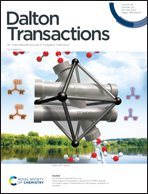A simple synthetic approach to enhance the thermal luminescence sensitivity of Tb3+ complexes with thiacalix[4]arene derivatives through upper-rim bromination†
Abstract
The present work for the first time reports an application of the thiacalix[4]arene scaffold for the preparation of Tb3+ complexes possessing high thermal luminescence sensitivity in the physiological temperature range of 20–50 °C. Non-substituted thiacalix[4]arenes form luminescent complexes with Tb3+ ions, but they do not reveal any meaningful thermal sensitivity. To solve this problem, an upper-rim bromination of thiacalix[4]arenes, as well as distal bromination along with the embedding of two 1,3-diketone substituents are proposed as new simple synthetic approaches to enhance the thermal luminescence sensitivity of the Tb3+ complexes. A combination of mass spectrometry, NMR, UV-Vis and luminescence spectroscopy with quantum chemical calculations reveals a dimeric structure of the complexes formed by thiacalix[4]arenes with Tb3+ ions in DMF solutions. The steady-state luminescence of the Tb3+ complexes has demonstrated more than one order higher thermal sensitivity for the complexes of bromo-substituted ligands in comparison with the non-substituted thiacalix[4]arenes. The reasons for such behavior are discussed. The results highlight new opportunities for the thiacalix[4]arene platform for controlling ligand-to-metal energy transfer in terbium complexes and tuning their thermo-responsive luminescence properties.
![Graphical abstract: A simple synthetic approach to enhance the thermal luminescence sensitivity of Tb3+ complexes with thiacalix[4]arene derivatives through upper-rim bromination](/en/Image/Get?imageInfo.ImageType=GA&imageInfo.ImageIdentifier.ManuscriptID=D0DT00709A&imageInfo.ImageIdentifier.Year=2020)


 Please wait while we load your content...
Please wait while we load your content...